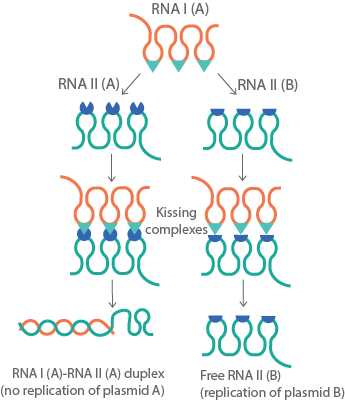Difference between revisions of "Part:BBa K2259005"
(→Origin of RNA I biobrick) |
|||
| Line 56: | Line 56: | ||
===Origin of RNA I biobrick=== | ===Origin of RNA I biobrick=== | ||
| − | In order to flexibly control the synthesis of RNA I, the RNA I gene first needed to be inactivated in ColE1 origin of replication. That, however, was not a trivial task, as ColE1 ORI is an antisense system, which means that by changing RNA I promoter sequence, one also changes the RNA II secondary structure, which is crucial for plasmid replication initiation (Find | + | In order to flexibly control the synthesis of RNA I, the RNA I gene first needed to be inactivated in ColE1 origin of replication. That, however, was not a trivial task, as ColE1 ORI is an antisense system, which means that by changing RNA I promoter sequence, one also changes the RNA II secondary structure, which is crucial for plasmid replication initiation (Find how this problem was solved at [[http://2017.igem.org/Team:Vilnius-Lithuania team Vilnius-Lithuania wiki]]). This is the main reason why, in SynORI framework, the wildtype ColE1 ORI is split into two different parts - <b> RNR I and RNA II </b>. |
<Picture of how RNA I promoter mutations might destroy RNA II secondary structure.> | <Picture of how RNA I promoter mutations might destroy RNA II secondary structure.> | ||
| − | |||
=Characterization of RNA I (Vilnius-Lithuania 2017)= | =Characterization of RNA I (Vilnius-Lithuania 2017)= | ||
Revision as of 09:43, 31 October 2017
SynORI framework RNA I - Plasmid replication Inhibitor (Wildtype)
RNA I acts as a plasmid replication inhibitor. RNA I gene transcript's secondary structures, which consists of three stem loops, binds to RNA II (replication initiator) secondary structures and - if succesful - inhibits plasmid replication initiation. Every SynORI RNA I part has it's wildtype promoter removed, and consequently, RNA I can be placed under any promoter signal pattern desired (Part:BBa_K2259086 is an exception, it is a fully wild type RNA I gene combined with wild type promoter).
- Caution! RNA I (Group A) indicates that this plasmid only interacts with the replication iniator RNA II (Group A) <LINK TO RNA II A> from SynORI (framework for multiplasmid systems) collection and is stable when placed with other SynORI plasmid groups. RNA II A will not be regulated with RNA I from another group!
See how this part fits into the whole SynORI framework by pressing here!
Sequence and Features
- 10COMPATIBLE WITH RFC[10]
- 12COMPATIBLE WITH RFC[12]
- 21COMPATIBLE WITH RFC[21]
- 23COMPATIBLE WITH RFC[23]
- 25COMPATIBLE WITH RFC[25]
- 1000COMPATIBLE WITH RFC[1000]
Introduction
Biology
ColE1 plasmid replication overview
ColE1-type plasmid replication begins with synthesis of plasmid encoded RNA II (also called primer transcript) by RNA polymerase which initiates transcription at a site 555bp upstream of origin of replication. The RNA transcript forms a RNA - DNA hybrid with template DNA near the origin of replication. Hybridized RNA is then cleaved at the replication origin by RNAse H and serves as a primer for DNA synthesis by DNA polymerase I (Figure 1. A).
Initiation of replication can be inhibited by plasmid encoded small RNA, called RNA I . Synthesis of RNA I starts 445 bp upstream of the replication origin and proceeds in the direction opposite to that of RNA II synthesis, and terminates near the RNA II transcription initiation site. RNA I binds to RNA II and thereby prevents formation of a secondary structure of RNA II that is necessary for hybridization of RNA II to the template DNA (Figure 1. B).
For RNA I to inhibit primer formation, it must bind before the nascent RNA II transcript extends to the replication origin. Consequently, the concentration of RNA I and the rate of binding of RNA I to RNA II is critical for regulation of primer formation and thus for plasmid replication.
Interaction between RNA I and RNA II can be amplified by Rop protein, see part:BBa_K2259010.
Rop dimer is a bundle of four tightly packed alpha helices that are held by hydrophobic interactions (Fig. 2).
Usage with SynORI (Framework for multi-plasmid systems)
About SynORI
SynORI is a framework for multi-plasmid systems created by Vilnius-Lithuania 2017 which enables quick and easy workflow with multiple plasmids, while also allowing to freely pick and modulate copy number for every unique plasmid group! Read more about [http://2017.igem.org/Team:Vilnius-Lithuania SynORI here]!
Regulative RNA I molecule in SynORI
The main goal of RNA I in the framework is group-specific control of copy number. Different plasmid copy numbers are achieved by changing RNA I concentration in the cell.
Specific RNA II versions in multi-plasmid systems
RNA II interacts with inhibitory RNA I with three secondary RNA stem loops. In order to create plasmid groups with independent copy number control, one group's RNA II molecule must interact only with the same group's RNA I molecule.
For example if there are two plasmid groups in a cell - A and B - RNA II of A group would only interact with RNA I A, and not RNA I B.
Origin of RNA I biobrick
In order to flexibly control the synthesis of RNA I, the RNA I gene first needed to be inactivated in ColE1 origin of replication. That, however, was not a trivial task, as ColE1 ORI is an antisense system, which means that by changing RNA I promoter sequence, one also changes the RNA II secondary structure, which is crucial for plasmid replication initiation (Find how this problem was solved at http://2017.igem.org/Team:Vilnius-Lithuania team Vilnius-Lithuania wiki). This is the main reason why, in SynORI framework, the wildtype ColE1 ORI is split into two different parts - RNR I and RNA II .
<Picture of how RNA I promoter mutations might destroy RNA II secondary structure.>
Characterization of RNA I (Vilnius-Lithuania 2017)
Constitutive Rop protein effect on plasmid copy number
To be updated!



